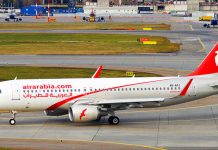Santos Dumont Airport is the second major airport serving Rio de Janeiro, Brazil. It is named after the Brazilian aviation pioneer Alberto Santos Dumont (1873–1932). It is operated by Infraero.
Santos Dumont has slot restrictions operating with a maximum of 19 operations/hour, being one of the five airports with such restrictions in Brazil.
Originally known as Calabouço Airport, the history of the airport can be traced back to the early 1930s. Until that time,the few aircraft equipped with landing gear used Manguinhos Airport.
Flight Landing at Santos Dumont Airport, Rio De Janeiro : VIDEO
Video of GOL Boeing 737 landing at Santos Dumont Airport, Rio De Janeiro. Video taken from Sugarloaf mountain.
Seaplanes, which at the time operated the majority of domestic and international flights, used a terminal located at the Calabouço Point, an area known today as Praça Marechal Âncora. Take-off and landings were made using an area of Guanabara Bay then known as estirão do Caju (Caju water stretch). It was as a development of the terminal at Calabouço Point that Calabouço Airport was created.
A new public terminal building for seaplanes was inaugurated on 29 October 1938. It was a replacement for the original passenger terminal and was used by all airlines except Panair do Brasil and Pan American World Airways, which used their own facilities. Due to the obsolescence of seaplanes, it ceased to be used in 1942. Today, this protected building houses the Historical and Cultural Institute of the Brazilian Air Force (INCAER).
In 1934, in order to handle a growing amount of land operations, land was reclaimed from the sea to create the first runway of the airport with a length of 1,300 feet (400 m). In 1936, the runway was extended to 2,300 feet (700 m) and on 30 November it received its first commercial flight, a VASP Junkers Ju 52 aircraft flying from São Paulo–Congonhas. The airport complex was inaugurated on 16 October 1936 and was named Santos Dumont Airport.
It was also in 1936 that the construction of a new passenger terminal began. It was a project led by the architects MMM Roberto (Marcelo, Milton and Mauricio Roberto Doria-Baptista) inspired in the Paris – Le Bourget Airport terminal. Its pioneering, modernist, architectural features created a Brazilian national landmark. It was only in 1947 that its construction was completed. This building continues to be used to the present day. In the lobby of this terminal, (now the arrivals terminal) two monumental paintings by Cadmo Fausto de Sousa can be seen. Named “Old Aviation” and “Modern Aviation”, they feature many old and new means of flying. Both were unveiled in 1951.
Adjoining the original seaplane terminal, Pan American World Airways and its Brazilian subsidiary Panair do Brasil constructed their own dedicated terminal for seaplanes and aircraft with landing gear. This terminal opened in 1937 featuring architecture inspired by the Pan American Seaplane Base and Terminal Building in Miami. It included a passenger terminal, offices and hangars. It remained the headquarters of Panair do Brasil until the airline was forced to cease its operations in 1965. It is now the headquarters of the Third Regional Air Command of the Brazilian Air Force.
On 21 May 1959 a formal agreement between Varig, Cruzeiro do Sul, and VASP created an air shuttle service (Portuguese: Ponte Aérea), the first of its kind in the world. This service operated between Rio de Janeiro–Santos Dumont Airport and São Paulo–Congonhas and comprised regular hourly departures, common check-in counter, and simplified tickets and formalities. The service was an instant success. Transbrasil joined the partnership in 1968. Starting in 1975 the service was operated exclusively by Varig’s Lockheed L-188 Electras. In 1999 this service came to an end because airlines decided to operate their own independent services.
Over the years, the airport’s main runway has been extended several times, first to 2,300 feet (700 m), then to 3,000 feet (910 m), and finally 4,340 feet (1,320 m).
With the gradual shift of international operations to Galeão Airport, opened in 1952, Rio de Janeiro–Santos Dumont lost its place as an international hub, but for many years retained its position of a major hub for domestic traffic, particularly until 1960, when the capital of Brazil was moved to Brasília. The airport handles only part of Rio’s short-to-medium haul domestic air traffic, and part of its general aviation and military operations. The airport is famous for having some of the shortest runways on which some Boeing and Airbus aircraft can land. An idea of these operations is given in the 007–James Bond film Moonraker of 1979, in which a Lockheed L-188 Electra briefly appears taking-off from the airport.
Due to a fire that almost destroyed the main terminal in 1999, the passenger terminal building was closed for 6 months.
On 26 May 2007, in time for the 2007 Pan American Games, a brand-new, modern extension of the original terminal was opened. This extension handles all departure operations, whilst the original terminal now handles all arrival operations. The new departures terminal increased the total capacity of the airport to 8.0 million passengers/year.
It was announced on 5 August 2009 that in order to renew its operational licence the Rio de Janeiro State Environment Institute (INEA) would require Santos Dumont Airport to adjust operational standards. After a meeting between INEA and Infraero held on 3 September 2009, the following compromise was reached: approach route 2 is used only when specific wind conditions that amount to 30% of total operations so require; the airport is closed between 23:00 and 06:00 hours: aircraft may depart or arrive until 22:30 hours, giving a half-hour tolerance period; and the maximum amount of flights per hour was reduced from 23 to 19.



















